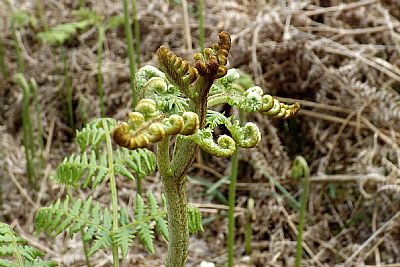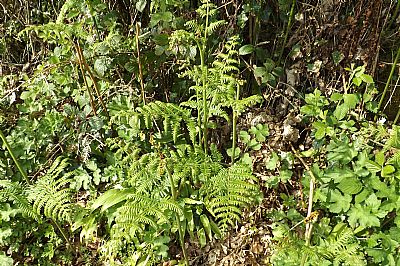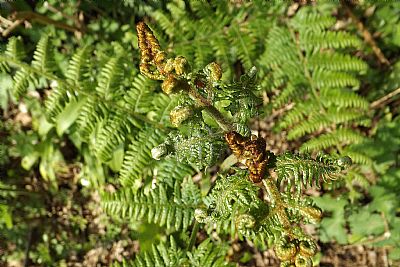BRACKEN : Pteridium aquilinum
Bracken covers great swathes of our muirland in similar proportions to grasses and heather. It dies back to a crisp grey-brown in winter. But in spring it regrows and you can watch its whole life-cycle in progress.
Some one may smuggly tell you that brackens and ferns are different plants. Actually brackens are ferns, but not all ferns are brackens.To be clearer Just compare the pinnate. The pinnate is the feather-like leafy bit that comes out of the stem. Ferns are bi-pinnate, which means that the leaflets divide twice to produce the easily recognised fronds. Bracken, on the other hand, is tri-pinnate. This means that the leaflets divide three times, giving each frond its own tiny frondlets – like a little green comb. [BioBlitz].
When mature it grows so high that it can reach make progress along forgotten paths quite difficult. It can also obscure that drainage ditch or simply trip you up. However in its full glory, it is a great green sight. It is a hardy everygreen.
Something else it can obscure is archaeological remnants such as cairns and hillforts. The drone pictures of Carman Hillfort were taken before it fully died down over the winter, but the fort outline was sufficiently clear to make it out. CARMAN HILLFORT, CARMAN MUIR
The Woodland Trust tells us : Bracken is the largest of our native ferns. It’s actually a ‘Pteridophyte’ which means that though it has vascular tissue like other plants, it reproduces by spores rather than seeds. Leaves/fronds: large, green, with triangular fronds which are divided and alternate down the stem. The fronds are tri-pinnate, which means that the leaflets which grow on each side the stem are themselves divided into leaflets as are those leaflets. New fronds unfurl from the base in the spring as a trio of small leaves or pinnules. Mature fronds are upright and sturdy and on the upper surface, they are usually leathery and shiny.
Bracken is considered by some to be poisonous. While you may see some livestock and deer eat it, they get deterred when young fronds are damaged as it produces hydrogen cyanide.

New bracken rise alongside the Leven towpath. Unlike other ferns, they have distinctive main stalks and branches.

Another difference between bracken and most ferns is that the new fronds unfurl much like a tight fist rather than the spiral fiddle heads.

This example from the RSPB Loch Lomond reserve shows new bracken emerging from the grey crisp mass from last year. The stalks are already quite tall and branched with the leaves unfurling.
BIO BLITZ blog by Simon Perks : https://bioblitzbristol.wordpress.com/2011/05/20/fern-or-bracken-its-all-in-the-pinnate/
BRITISH PTERIDOLOGICAL SOCIETY website. This shows all of the "common" fer.ns in the UK.: https://ebps.org.uk/ferns/identification/key-to-common-british-native-ferns/common-native-ferns/
GARDENERS WORLD : https://forum.gardenersworld.com/discussion/1031457/ferns-or-bracken
NATURE SCOT : https://www.nature.scot/plants-animals-and-fungi/ferns/bracken
SCOTLAND GUIDE : https://www.scotlandguides.org/ferns-epiphytic-plant-in-scotland.html
SCOTLAND'S NATURE : Discussion on Gaelic names for ferns: https://scotlandsnature.blog/2015/11/24/fern-scotland/
US FOREST SERVICE : https://www.fs.usda.gov/wildflowers/beauty/ferns/structure.shtml
WILDLIFE TRUSTS : https://www.wildlifetrusts.org/wildlife-explorer/ferns-and-horsetails/bracken & https://www.wildlifetrusts.org/wildlife-explorer/ferns-and-horsetails/male-fern
WIKI DIFF : https://wikidiff.com/bracken/fern?utm_content=cmp-true
WOODLAND TRUST : https://www.woodlandtrust.org.uk/trees-woods-and-wildlife/plants/ferns/bracken/ & https://www.woodlandtrust.org.uk/trees-woods-and-wildlife/plants/ferns/hard-fern/

